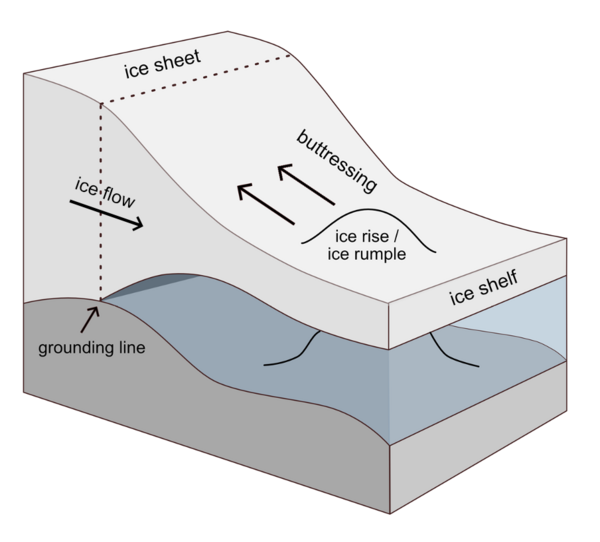How ice rises and rumples affect the Antarctic ice sheet
Wherever ice shelves ground locally on the elevated seabed, ice rises can form, causing the flowing ice shelf to be diverted around the grounded region. On smaller elevated seabed anomalies, ice rumples can form, where the ice shelf flows over the grounded region (see figure 1). These islands surrounded by otherwise floating ice shelves play a key role buttressing discharge from the Antarctic Ice Sheet and regulating its contribution to sea level.
In the study, the authors A. Clara J. Henry and Clemens Schannwell (Max Planck Institute for Meteorology), Vjeran Višnjević and Reinhard Drews (University of Tübingen), investigate the evolution of ice rises. Because there are over 700 ice rises all around Antarctica, it is important to improve the understanding of their role in Antarctic ice sheet dynamics: The Antarctic ice sheet is the largest remaining ice sheet on the planet and has the potential to raise the global sea level by around 58 m. In addition, it is the largest source of uncertainty in sea level rise projections. Coastal Antarctica is particularly susceptible to a changing climate, necessitating a better understanding of the dominant physical processes there.
As climate and sea level change, ice rises respond by either increasing or decreasing in size. The change in size influences the flow of ice and can have an effect on the total Antarctic ice volume. Ice rises hold back or buttress the ice shelf, regulating the flow of ice and influencing the location of the grounding line. Because these features change in size over glacial cycles, they alter ice shelf buttressing. When there is an increase in sea level, ice rises reduce in size and provide less buttressing, increasing the speed of the ice shelf and resulting in a loss of ice from the Antarctic ice sheet. When the sea level decreases, the grounded area of ice rises increases, but with a time delay. This behavior is called hysteresis and has important implications for the Antarctic ice sheet evolution.
Ice rises and ice rumples are found all around the perimeter of the Antarctic Ice Sheet, but the mechanisms governing the transition from one flow regime to the other had previously not been investigated, and influences of the surrounding ice shelves on the local flow regimes had not yet been quantified. In order to explore these questions, the scientists use the three-dimensional, full Stokes model Elmer/Ice to simulate idealized ice rises and ice rumples under various basal friction scenarios and sea level perturbations.
This allows them to identify a hysteretic response of ice rises and ice rumples to changes in the sea level, with grounded area being larger in a sea-level-increase scenario than in a sea-level-decrease scenario. This hysteresis shows not only irreversibility following an equal increase and subsequent decrease in the sea level but also that the perturbation history is important for inferring the past ice rise or ice rumple geometry. The initial grounded area needs to be carefully considered, as this will determine the formation of either an ice rise or an ice rumple, thereby causing different buttressing effects.
Original publication
Henry, C. J., Drews, R., Schannwell, C., & Visnjevic, V. (2022). Hysteretic evolution of ice rises and ice rumples with variations in sea level. The Cryosphere, 16, 3889-3905. doi: 10.5194/tc-16-3889-2022
Contact
Clara Henry
PhD candidate
Max Planck Institute for Meteorology
Email: clara.henry@mpimet.mpg.de
Dr. Clemens Schannwell
Max Planck Institute for Meteorology
Email: clemens.schannwell@mpimet.mpg.de

